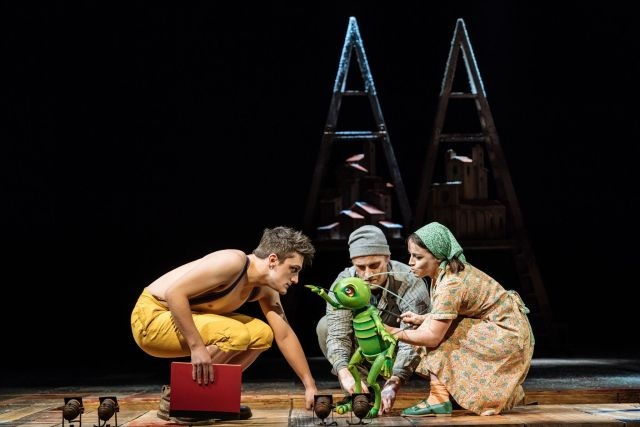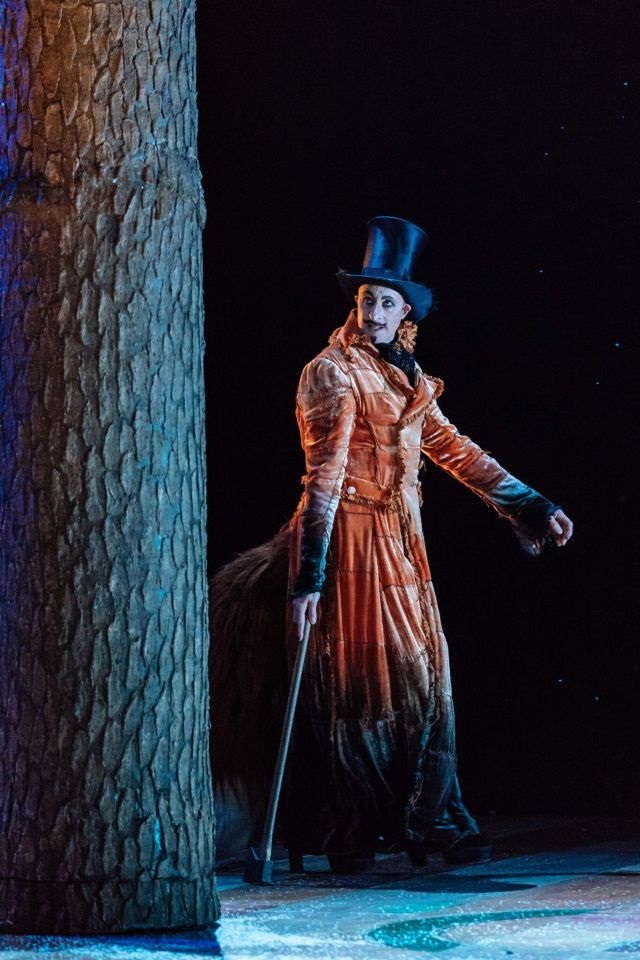Pinocchio, National Theatre review - boy puppet lifts off, eventually | reviews, news & interviews
Pinocchio, National Theatre review - boy puppet lifts off, eventually
Pinocchio, National Theatre review - boy puppet lifts off, eventually
Look no strings: long-nosed cartoon character is humanised by a magical staging

From Nicholas Hytner and Alan Bennett’s wonderfully nostalgic version of The Wind in the Willows through Coram Boy, the international smash hit War Horse and beyond, the National Theatre has a startling track record in turning what used to be patronisingly regarded as “family<
If there’s one thing Disney knows, it’s how to exploit its back catalogue. So it’s no accident that Pinocchio, one of its earliest and most venerated feature-length animations, has not previously made the leap from screen to stage. The studio has clearly been wary, probably because not only was the 1940 movie initially an unexpected flop but chiefly because it’s less of a story than a conceit. And it’s that problem that this adaptation of Carlo Collodi’s original 19th century story (mixed with elements and songs from Disney) largely fails to solve. The opening image sets the show’s tone of cunning simplicity. On designer Bob Crowley’s cavernous, near-empty, black-box stage stands a tall, single tree trunk amid falling snow spectrally lit by Paule Constable. Magic is then woven in full view (no expensive but hidden special effects here) as Pinocchio, taut and buoyant Joe Idris-Roberts (main picture), is created in front of our eyes. Everything feels fully (old)-fashioned to a degree that is charming.
The opening image sets the show’s tone of cunning simplicity. On designer Bob Crowley’s cavernous, near-empty, black-box stage stands a tall, single tree trunk amid falling snow spectrally lit by Paule Constable. Magic is then woven in full view (no expensive but hidden special effects here) as Pinocchio, taut and buoyant Joe Idris-Roberts (main picture), is created in front of our eyes. Everything feels fully (old)-fashioned to a degree that is charming.
At this point, the production’s reverse notion becomes clear: Pinocchio, the puppet who wants to be human, is played by an actor but all the other major characters are played by giant, 10-foot-tall puppets which, in the manner of War Horse, are manipulated by groups of visible puppeteers (directed and co-designed by Toby Olié). Inventive though this is, it has a considerable downside in that each of the actors voicing their puppet is detached from them. They sound – and, indeed are – at one remove with lines dangerously slowed to match movement. Speeches sound declaimed rather than spoken. The little tension provided by the plot evaporates.
 Director John Tiffany (Once, Harry Potter and The Cursed Child) and writer Dennis Kelly (Matilda) reimagine characters, not least Audrey Brisson voicing a prissy, gender-switched Jiminy Cricket (pictured above), while orange-rag-coated David Langham becomes a wonderfully tall sneer of the villainous fox (pictured right). But they wrestle with the lack of subtext and not all the set-piece numbers that could cover the weaknesses manage to take wing. Steven Hoggett is a superb movement director who brings energy to characters but, despite utilising Crowley’s wittily retro circus costumes and set, he fails to galvanise the ensemble in the number “I’ve Got No Strings” which lacks gathering excitement.
Director John Tiffany (Once, Harry Potter and The Cursed Child) and writer Dennis Kelly (Matilda) reimagine characters, not least Audrey Brisson voicing a prissy, gender-switched Jiminy Cricket (pictured above), while orange-rag-coated David Langham becomes a wonderfully tall sneer of the villainous fox (pictured right). But they wrestle with the lack of subtext and not all the set-piece numbers that could cover the weaknesses manage to take wing. Steven Hoggett is a superb movement director who brings energy to characters but, despite utilising Crowley’s wittily retro circus costumes and set, he fails to galvanise the ensemble in the number “I’ve Got No Strings” which lacks gathering excitement.
His work, and that of everyone else, comes alive in the second half in which Pinocchio is whisked off to Pleasure Island. Here, Pinocchio’s Candide-like naivety is tested by the show’s exploration of wickedness that masquerades as non-stop fun. With Pinocchio and a bunch of kids let loose to do whatever they want, it’s as if everyone is in the pleauredome that is Pottersville in It’s a Wonderful Life. Finally, predictability disappears and a degree of tension arises.
From there on, up to and including a superbly staged extended sequence in the belly of a whale – a fusion of light, sound, music, drama and even flying – you feel the entire audience capitulating to the production’s considerable spell. Much of this is down not just to Tiffany but also Martin Lowe, whose deliciously tasty, unexpected and varied musical arrangements and filmic underscoring for 15-piece orchestra (with acres of harp writing) under conductor Tom Brady provide exceptionally vivid atmosphere.
This show is likely to be the first visit to the theatre for a large percentage of its audience. For eight-year-olds upwards, the arrestingly beautiful design will see them through. That, and the ultimately affecting, heart-on-sleeve message of the script that shows us love and pain and even (yes) the human condition.
rating
Share this article
The future of Arts Journalism
You can stop theartsdesk.com closing!
We urgently need financing to survive. Our fundraising drive has thus far raised £49,000 but we need to reach £100,000 or we will be forced to close. Please contribute here: https://gofund.me/c3f6033d
And if you can forward this information to anyone who might assist, we’d be grateful.

Subscribe to theartsdesk.com
Thank you for continuing to read our work on theartsdesk.com. For unlimited access to every article in its entirety, including our archive of more than 15,000 pieces, we're asking for £5 per month or £40 per year. We feel it's a very good deal, and hope you do too.
To take a subscription now simply click here.
And if you're looking for that extra gift for a friend or family member, why not treat them to a theartsdesk.com gift subscription?
more Theatre
 The Two Gentlemen of Verona, RSC, Stratford review - not quite the intended gateway drug to Shakespeare
Shakespeare trying out lots of ideas that were to bear fruit in the future
The Two Gentlemen of Verona, RSC, Stratford review - not quite the intended gateway drug to Shakespeare
Shakespeare trying out lots of ideas that were to bear fruit in the future
 Edinburgh Fringe 2025 reviews: The Horse of Jenin / Nowhere
Two powerful shows consider the Israeli-Palestinian conflict, with mixed results
Edinburgh Fringe 2025 reviews: The Horse of Jenin / Nowhere
Two powerful shows consider the Israeli-Palestinian conflict, with mixed results
 Edinburgh Fringe 2025 reviews: The Fit Prince / Undersigned
A joyful gay romance and an intimate one-to-one encounter in two strong Fringe shows
Edinburgh Fringe 2025 reviews: The Fit Prince / Undersigned
A joyful gay romance and an intimate one-to-one encounter in two strong Fringe shows
 Tom at the Farm, Edinburgh Fringe 2025 review - desire and disgust
A visually stunning stage re-adaptation of a recent gay classic plunges the audience into blood and earth
Tom at the Farm, Edinburgh Fringe 2025 review - desire and disgust
A visually stunning stage re-adaptation of a recent gay classic plunges the audience into blood and earth
 Works and Days, Edinburgh International Festival 2025 review - jaw-dropping theatrical ambition
Nothing less than the history of human civilisation is the theme of FC Bergman's visually stunning show
Works and Days, Edinburgh International Festival 2025 review - jaw-dropping theatrical ambition
Nothing less than the history of human civilisation is the theme of FC Bergman's visually stunning show
 Every Brilliant Thing, @sohoplace review - return of the comedy about suicide that lifts the spirits
Lenny Henry is the ideal ringmaster for this exercise in audience participation
Every Brilliant Thing, @sohoplace review - return of the comedy about suicide that lifts the spirits
Lenny Henry is the ideal ringmaster for this exercise in audience participation
 Edinburgh Fringe 2025 reviews: The Beautiful Future is Coming / She's Behind You
A deft, epoch-straddling climate six-hander and a celebration (and take-down) of the pantomime dame at the Traverse Theatre
Edinburgh Fringe 2025 reviews: The Beautiful Future is Coming / She's Behind You
A deft, epoch-straddling climate six-hander and a celebration (and take-down) of the pantomime dame at the Traverse Theatre
 Good Night, Oscar, Barbican review - sad story of a Hollywood great's meltdown, with a dazzling turn by Sean Hayes
Oscar Levant is an ideal subject to refresh the debate about media freedom
Good Night, Oscar, Barbican review - sad story of a Hollywood great's meltdown, with a dazzling turn by Sean Hayes
Oscar Levant is an ideal subject to refresh the debate about media freedom
 Edinburgh Fringe 2025 reviews - Monstering the Rocketman by Henry Naylor / Alex Berr
Tabloid excess in the 1980s; gallows humour in reflections on life and death
Edinburgh Fringe 2025 reviews - Monstering the Rocketman by Henry Naylor / Alex Berr
Tabloid excess in the 1980s; gallows humour in reflections on life and death
 Edinburgh Fringe 2025 reviews: Lost Lear / Consumed
Twists in the tail bring revelations in two fine shows at the Traverse Theatre
Edinburgh Fringe 2025 reviews: Lost Lear / Consumed
Twists in the tail bring revelations in two fine shows at the Traverse Theatre
 Make It Happen, Edinburgh International Festival 2025 review - tutting at naughtiness
James Graham's dazzling comedy-drama on the rise and fall of RBS fails to snarl
Make It Happen, Edinburgh International Festival 2025 review - tutting at naughtiness
James Graham's dazzling comedy-drama on the rise and fall of RBS fails to snarl
 Edinburgh Fringe 2025 reviews: I'm Ready To Talk Now / RIFT
An intimate one-to-one encounter and an examination of brotherly love at the Traverse Theatre
Edinburgh Fringe 2025 reviews: I'm Ready To Talk Now / RIFT
An intimate one-to-one encounter and an examination of brotherly love at the Traverse Theatre

Add comment